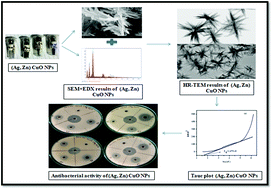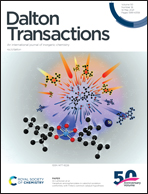Effect of (Ag, Zn) co-doping on structural, optical and bactericidal properties of CuO nanoparticles synthesized by a microwave-assisted method
Abstract
A microwave assisted synthesis method has been used for the fabrication of pure and (Ag, Zn) co-doped copper oxide (Cu1−x−yAgxZnyO) nanoparticles (NPs) with different weight ratios of zinc (0.00, 0.02, 0.04, 0.06, and 0.08 M) at a constant weight ratio of silver (0.02 M). The structure and morphology of the prepared samples were analyzed by X-ray diffraction (XRD), field emission scanning electron microscopy (FE-SEM), energy dispersive X-ray diffraction (EDX), high resolution transmission electron microscopy (HR-TEM), UV–Vis spectrophotometry and Fourier transform infrared (FTIR) spectroscopy. XRD results showed that both pure and (Ag, Zn) co-doped copper oxide (CuO) NPs have a single phase monoclinic structure and no secondary phases were detected. The average crystallite size values of the NPs were found to be 13.10, 14.45, 17.59, 19.72 and 20.33 nm. FE-SEM images confirmed the changes in the morphology of pure copper oxide (CuO) NPs due to co-doping with silver and zinc metal ions. The EDX of the samples provided both semi-qualitative and semi-quantitative information. EDX confirmed the presence of Ag and Zn elements in the CuO lattice. HR-TEM images confirmed that the morphology of pure CuO was found to change from ellipsoidal to star-like structures after co-doping with Ag and Zn ions. The images also established the particle size in a range of 13.88–21.13 nm. The HR-TEM results were in agreement with the XRD results. Tauc's plots were used to determine the optical band gap of the NPs. The band gap for direct transitions was found to be 1.42–1.73 eV and that for indirect transitions was in a range of 1.28–1.78 eV. The functional group properties were also discussed using FTIR techniques. The antibacterial activity of the synthesized NPs was tested against Gram positive (Staphylococcus aureus and Bacillus subtilis) and Gram negative (Escherichia coli and Pseudomonas aeruginosa) pathogenic bacteria by an agar well diffusion method. The zones of inhibition were found to be the maximum for co-doped CuO NPs as compared to pure CuO NPs for three bacterial strains Escherichia coli, Staphylococcus aureus and Pseudomonas aeruginosa. It is also believed that the studied material due to its remarkable properties may be an efficient alternative in the development of smart systems for the detection of pathogens and as antimicrobial agents.



 Please wait while we load your content...
Please wait while we load your content...